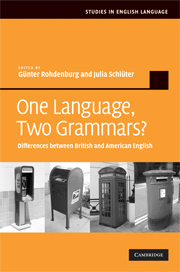Book contents
- Frontmatter
- Contents
- List of figures
- List of tables
- List of contributors
- Introduction
- 1 Colonial lag, colonial innovation or simply language change?
- 2 Compound verbs
- 3 The formation of the preterite and the past participle
- 4 Synthetic and analytic comparatives
- 5 Phonology and grammar
- 6 Prepositions and postpositions
- 7 Argument structure
- 8 Reflexive structures
- 9 Noun phrase modification
- 10 Nominal complements
- 11 Non-finite complements
- 12 The present perfect and the preterite
- 13 The revived subjunctive
- 14 The mandative subjunctive
- 15 The conditional subjunctive
- 16 Tag questions
- 17 The pragmatics of adverbs
- 18 How different are American and British English grammar? And how are they different?
- 19 New departures
- Bibliography
- Index
19 - New departures
Published online by Cambridge University Press: 03 July 2009
- Frontmatter
- Contents
- List of figures
- List of tables
- List of contributors
- Introduction
- 1 Colonial lag, colonial innovation or simply language change?
- 2 Compound verbs
- 3 The formation of the preterite and the past participle
- 4 Synthetic and analytic comparatives
- 5 Phonology and grammar
- 6 Prepositions and postpositions
- 7 Argument structure
- 8 Reflexive structures
- 9 Noun phrase modification
- 10 Nominal complements
- 11 Non-finite complements
- 12 The present perfect and the preterite
- 13 The revived subjunctive
- 14 The mandative subjunctive
- 15 The conditional subjunctive
- 16 Tag questions
- 17 The pragmatics of adverbs
- 18 How different are American and British English grammar? And how are they different?
- 19 New departures
- Bibliography
- Index
Summary
Outline
Rather than a conclusion summing up the findings from the present volume, this final chapter forms an outlook that is intended to foster a continuation of the work begun by the contributors. The authors of this chapter and editors of this volume do not pretend that the differences between BrE and AmE grammar studied in the preceding chapters can be adequately summarized in a few pages or that a few concluding remarks can do justice to the multiplicity of findings discussed (for some suggestions, see the general Introduction). The array of contrasts from the most diverse areas of grammar forbid us to even venture the attempt. Too many of the traditional generalizations about British–American contrasts have been confronted with counter-evidence, yielding a highly differentiated picture.
What becomes more than clear in view of the data gathered in this volume is that, contrary to general opinion, BrE and AmE do not differ only in their pronunciation and lexicon, but also in central domains of their grammar. Thus, the most important lesson to be drawn from the preceding studies is the one expressed by Gunnel Tottie in Chapter 18: ‘the more delicate our analysis, the more differences we will find’.
In line with this conclusion, the present chapter suggests numerous avenues for further research on British–American contrasts. It contains almost four dozen pilot studies, roughly grouped into five grammatical categories.
- Type
- Chapter
- Information
- One Language, Two Grammars?Differences between British and American English, pp. 364 - 423Publisher: Cambridge University PressPrint publication year: 2009
- 13
- Cited by



